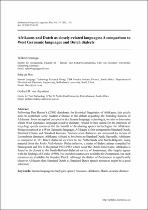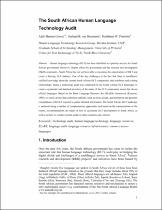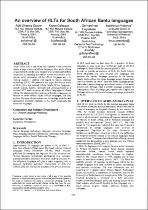 ResearchSpace
ResearchSpace
Afrikaans and Dutch as closely-related languages: A comparison to West Germanic languages and Dutch dialects
JavaScript is disabled for your browser. Some features of this site may not work without it.
- ResearchSpace
- →
- Research Publications/Outputs
- →
- Journal Articles
- →
- View Item
| dc.contributor.author |
Heeringa, W

|
|
| dc.contributor.author |
De Wet, Febe

|
|
| dc.contributor.author |
Van Huyssteen, GB

|
|
| dc.date.accessioned | 2016-07-11T10:58:29Z | |
| dc.date.available | 2016-07-11T10:58:29Z | |
| dc.date.issued | 2015-07 | |
| dc.identifier.citation | Heeringa, W, De Wet, F and Van Huyssteen, GB. 2015. Afrikaans and Dutch as closely-related languages: A comparison to West Germanic languages and Dutch dialects. Stellenbosch Papers in Linguistics Plus, Vol 47, pp. 1-18 | en_US |
| dc.identifier.issn | 1726-541X | |
| dc.identifier.uri | http://spilplus.journals.ac.za/pub/article/view/649/613 | |
| dc.identifier.uri | http://hdl.handle.net/10204/8630 | |
| dc.description | Copyright: 2015 University of Stellenbosch. Department of General Linguistics | en_US |
| dc.description.abstract | Following Den Besten’s (2009) desiderata for historical linguistics of Afrikaans, this article aims to contribute some modern evidence to the debate regarding the founding dialects of Afrikaans. From an applied perspective (i.e. human language technology), we aim to determine which West Germanic language(s) and/or dialect(s) would be best suited for the purposes of recycling speech resources for the benefit of developing speech technologies for Afrikaans. Being recognised as a West Germanic language, Afrikaans is first compared to Standard Dutch, Standard Frisian and Standard German. Pronunciation distances are measured by means of Levenshtein distances. Afrikaans is found to be closest to Standard Dutch. Secondly, Afrikaans is compared to 361 Dutch dialectal varieties in the Netherlands and North-Belgium, using material from the Reeks Nederlandse Dialectatlassen, a series of dialect atlases compiled by Blancquaert and Pée in the period 1925-1982 which cover the Dutch dialect area. Afrikaans is found to be closest to the South-Holland dialectal variety of Zoetermeer; this largely agrees with the findings of Kloeke (1950). No speech resources are available for Zoetermeer, but such resources are available for Standard Dutch. Although the dialect of Zoetermeer is significantly closer to Afrikaans than Standard Dutch is, Standard Dutch speech resources might be a good substitute. | en_US |
| dc.language.iso | en | en_US |
| dc.publisher | University of Stellenbosch. Department of General Linguistics | en_US |
| dc.relation.ispartofseries | Workflow;16045 | |
| dc.subject | Human language technologies | en_US |
| dc.subject | Speech resources | en_US |
| dc.subject | Afrikaans language | en_US |
| dc.subject | Dutch language | en_US |
| dc.subject | Acoustic distance | en_US |
| dc.title | Afrikaans and Dutch as closely-related languages: A comparison to West Germanic languages and Dutch dialects | en_US |
| dc.type | Article | en_US |
| dc.identifier.apacitation | Heeringa, W., De Wet, F., & Van Huyssteen, G. (2015). Afrikaans and Dutch as closely-related languages: A comparison to West Germanic languages and Dutch dialects. http://hdl.handle.net/10204/8630 | en_ZA |
| dc.identifier.chicagocitation | Heeringa, W, Febe De Wet, and GB Van Huyssteen "Afrikaans and Dutch as closely-related languages: A comparison to West Germanic languages and Dutch dialects." (2015) http://hdl.handle.net/10204/8630 | en_ZA |
| dc.identifier.vancouvercitation | Heeringa W, De Wet F, Van Huyssteen G. Afrikaans and Dutch as closely-related languages: A comparison to West Germanic languages and Dutch dialects. 2015; http://hdl.handle.net/10204/8630. | en_ZA |
| dc.identifier.ris | TY - Article AU - Heeringa, W AU - De Wet, Febe AU - Van Huyssteen, GB AB - Following Den Besten’s (2009) desiderata for historical linguistics of Afrikaans, this article aims to contribute some modern evidence to the debate regarding the founding dialects of Afrikaans. From an applied perspective (i.e. human language technology), we aim to determine which West Germanic language(s) and/or dialect(s) would be best suited for the purposes of recycling speech resources for the benefit of developing speech technologies for Afrikaans. Being recognised as a West Germanic language, Afrikaans is first compared to Standard Dutch, Standard Frisian and Standard German. Pronunciation distances are measured by means of Levenshtein distances. Afrikaans is found to be closest to Standard Dutch. Secondly, Afrikaans is compared to 361 Dutch dialectal varieties in the Netherlands and North-Belgium, using material from the Reeks Nederlandse Dialectatlassen, a series of dialect atlases compiled by Blancquaert and Pée in the period 1925-1982 which cover the Dutch dialect area. Afrikaans is found to be closest to the South-Holland dialectal variety of Zoetermeer; this largely agrees with the findings of Kloeke (1950). No speech resources are available for Zoetermeer, but such resources are available for Standard Dutch. Although the dialect of Zoetermeer is significantly closer to Afrikaans than Standard Dutch is, Standard Dutch speech resources might be a good substitute. DA - 2015-07 DB - ResearchSpace DP - CSIR KW - Human language technologies KW - Speech resources KW - Afrikaans language KW - Dutch language KW - Acoustic distance LK - https://researchspace.csir.co.za PY - 2015 SM - 1726-541X T1 - Afrikaans and Dutch as closely-related languages: A comparison to West Germanic languages and Dutch dialects TI - Afrikaans and Dutch as closely-related languages: A comparison to West Germanic languages and Dutch dialects UR - http://hdl.handle.net/10204/8630 ER - | en_ZA |








